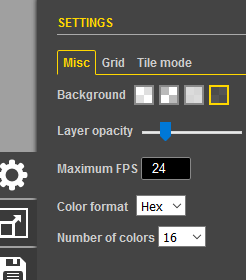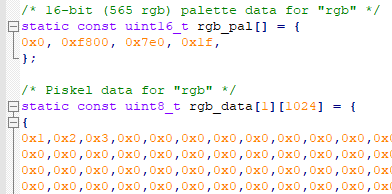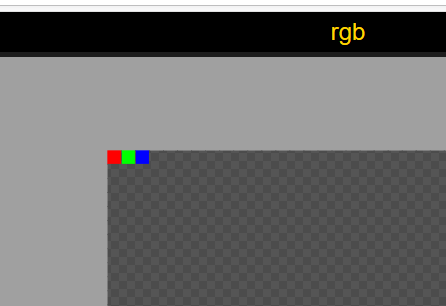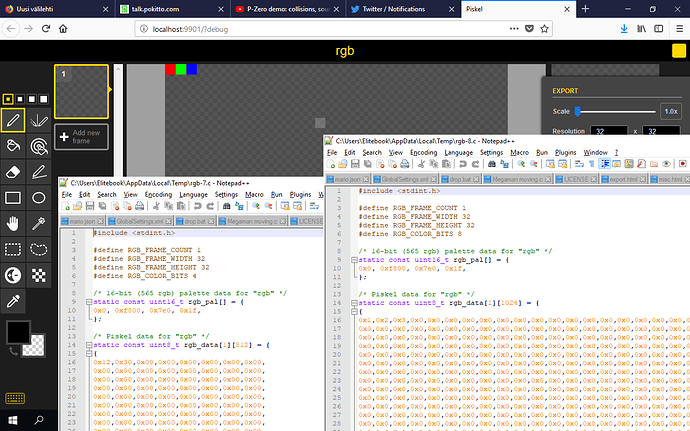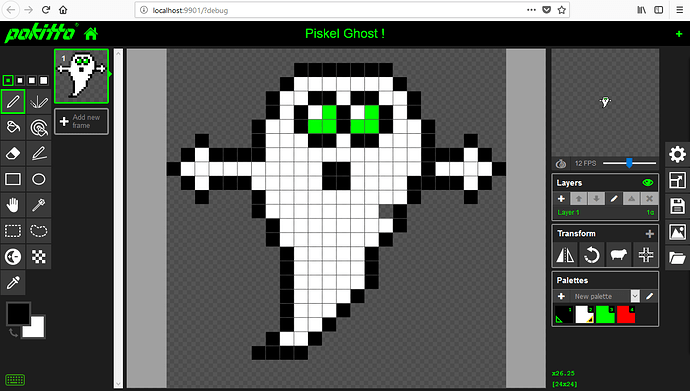The equivalent of the output of that image would be:
#pragma once
#include <cstdint>
constexpr std::uint32_t piskel_ghost_frame_count = 1;
constexpr std::uint32_t piskel_ghost_frame_width = 24;
constexpr std::uint32_t piskel_ghost_frame_height = 24;
constexpr std::uint32_t piskel_ghost_color_bits = 4;
// 16-bit (565 rgb) palette data for "Piskel Ghost"
static const std::uint16_t piskel_ghost_pal[] =
{
0x0, 0xffff, 0x7e0, 0xf800,
};
// Piskel data for "Piskel Ghost"
static const std::uint8_t piskel_ghost_data[piskel_ghost_frame_count][288] =
{
{
0x00,0x00,0x00,0x00,0x00,0x00,
0x00,0x00,0x00,0x00,0x00,0x00,
0x00,0x00,0x00,0x00,0x00,0x00,
0x00,0x00,0x00,0x00,0x00,0x00,
0x00,0x00,0x00,0x00,0x01,0x11,
0x11,0x11,0x00,0x00,0x00,0x00,
0x00,0x00,0x00,0x00,0x11,0x00,
0x10,0x01,0x10,0x00,0x00,0x00,
0x00,0x00,0x00,0x00,0x10,0x12,
0x01,0x20,0x10,0x00,0x00,0x00,
0x00,0x00,0x00,0x01,0x10,0x22,
0x02,0x20,0x11,0x00,0x00,0x00,
0x00,0x00,0x00,0x01,0x11,0x00,
0x10,0x01,0x11,0x00,0x00,0x00,
0x00,0x10,0x00,0x01,0x11,0x11,
0x11,0x11,0x11,0x00,0x01,0x00,
0x01,0x11,0x11,0x11,0x11,0x10,
0x01,0x11,0x11,0x01,0x11,0x10,
0x00,0x10,0x00,0x11,0x11,0x10,
0x01,0x11,0x10,0x00,0x01,0x00,
0x00,0x00,0x00,0x01,0x11,0x11,
0x11,0x11,0x10,0x00,0x00,0x00,
0x00,0x00,0x00,0x01,0x11,0x11,
0x11,0x10,0x00,0x00,0x00,0x00,
0x00,0x00,0x00,0x00,0x11,0x11,
0x11,0x11,0x00,0x00,0x00,0x00,
0x00,0x00,0x00,0x00,0x11,0x11,
0x11,0x10,0x00,0x00,0x00,0x00,
0x00,0x00,0x00,0x00,0x01,0x11,
0x11,0x00,0x00,0x00,0x00,0x00,
0x00,0x00,0x00,0x00,0x01,0x11,
0x11,0x00,0x00,0x00,0x00,0x00,
0x00,0x00,0x00,0x00,0x01,0x11,
0x11,0x00,0x00,0x00,0x00,0x00,
0x00,0x00,0x00,0x00,0x01,0x11,
0x10,0x00,0x00,0x00,0x00,0x00,
0x00,0x00,0x00,0x00,0x01,0x11,
0x00,0x00,0x00,0x00,0x00,0x00,
0x00,0x00,0x00,0x00,0x01,0x10,
0x00,0x00,0x00,0x00,0x00,0x00,
0x00,0x00,0x00,0x00,0x11,0x00,
0x00,0x00,0x00,0x00,0x00,0x00,
0x00,0x00,0x00,0x00,0x00,0x00,
0x00,0x00,0x00,0x00,0x00,0x00,
0x00,0x00,0x00,0x00,0x00,0x00,
0x00,0x00,0x00,0x00,0x00,0x00,
0x00,0x00,0x00,0x00,0x00,0x00,
0x00,0x00,0x00,0x00,0x00,0x00,
}
};
The main differences:
-
#pragma once is desirable if the file is going to be included as a .h file, it will ‘multiple definition’ errors if the header is included more than once
-
#include <cstdint> should be preferred because #include <stdint.h> is deprecated (see here and/or here.)
- When using
cstdint, expect the fixed width integer types to be in the std namespace. Many implementations also put them in the global namspace, but that’s not guaranteed by the standard
-
constexpr variables should be preferred over macros because the identifiers are confined to a specific namespace (in this case, the global namespace), whereas macros pollute the entire translation unit
Other things of note:
- Naming conventions are debatable
- Brace style is debatable
- Indentation style is debatable
- Spelling is debatable
It would be good (though not strictly necessary) to be able to choose which styles are used in the output.

